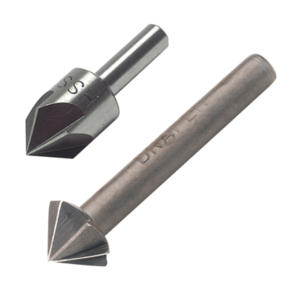Countersink Bits: Difference between revisions
From DT Online
(Added Template) |
mNo edit summary |
||
| Line 1: | Line 1: | ||
[[File:CskBits.png| | [[File:CskBits.png|300px|right]] | ||
__TOC__ | __TOC__ | ||
Revision as of 09:38, 15 May 2016
Description
Countersink Bits or drills, are used to Chamfer or bevel the edge of a drilled hole such that a Countersunk Head Screw can be seated flush with material surface.
Features and Uses
They are available in a range of point angles but the most common for general purposes is 90°. Short fluted designs are chosen for working in metal and are made of High Speed Steel (HSS) for this purpose. The longer Rose Countersink is made of Carbon Steel but is often preferred for working in wood.
Rose Countersinks are also available fixed in a file handle so that they can be used by hand. This can be more convenient than constantly changing the bit in drill when only a few holes need countersinking in wood.
Centre Drills (aka Slocombe Drills) were designed to provide a location for a Tailstock Centre (hence their 60deg point angle) but are commonly used to make a small starting indentation to guide further drilling in a Lathe.
- If used only to start a drilled hole then one or two of the mid-range sizes will suffice since it is only the tip of the Centre Drill that will be used.
- Choose only those made from good quality High Speed Steel and offer them carefully up to the workpiece whilst it is rotating since the smaller sizes in particular, can break easily.
 |
| Slocombe Centre Drill |
